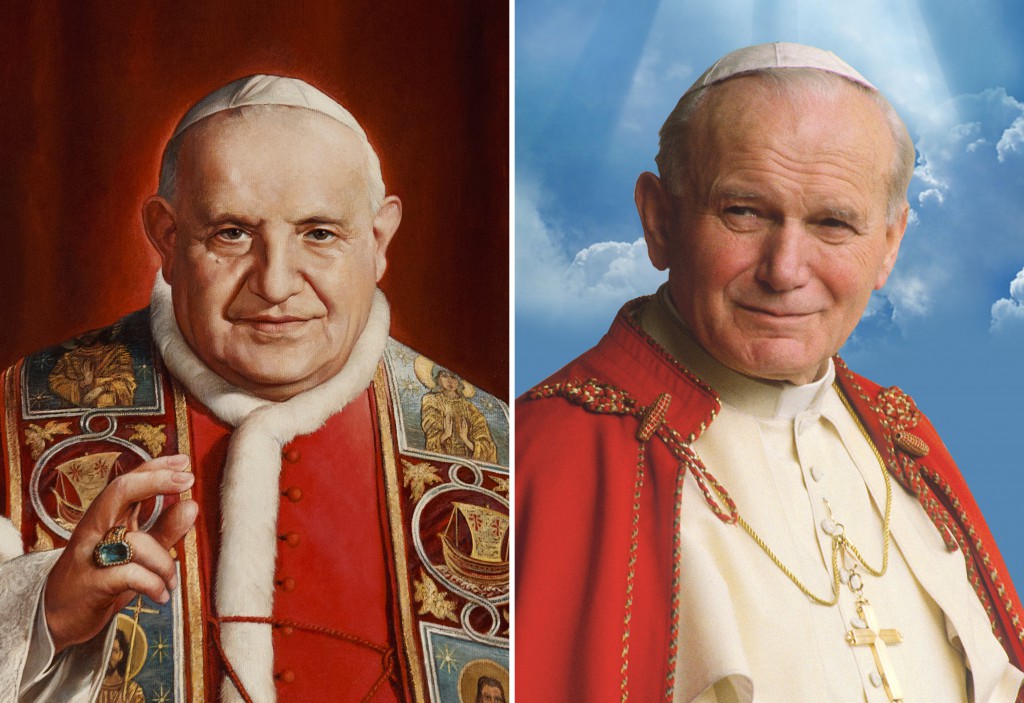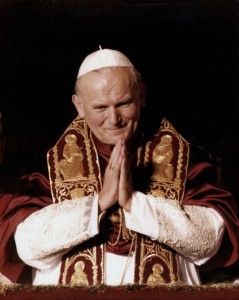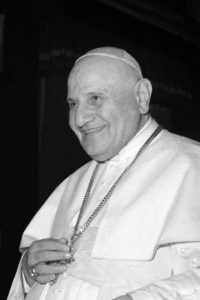

When Pope Francis canonizes Blessed John XXIII and Blessed John Paul II this month, the eyes of the world will turn toward Rome. Some of them will fill with tears of joy.
More than 1 million people are expected to press into the Eternal City to honor John XXIII and John Paul II on April 27. It is there that they will be declared saints by Pope Francis.
Many more will witness the historic event from afar, following along via television and social media.
Christine Accurso, director of 1st Way Pregnancy Support Center, said that Blessed John Paul II had an enormous effect on her life. She choked back emotion as she considered what it meant that she and her husband will soon be in Rome for the canonization Mass.
“John Paul the Great was the single human being who had the most impact on my life so far. He is like a father to me,” Accurso said. “He taught me so much about who I am, about who we are as human persons, about who God is. He has affected how I approach everything in my life.”
Local author, entrepreneur and speaker Chris Faddis remembers a personal encounter he had with Pope John Paul II back in 1995 while on pilgrimage to Rome with his youth group.[quote_right]“John Paul the Great was the single human being who had the most impact on my life so far. He is like a father to me.” — Christine Accurso[/quote_right]
The Holy Father greeted the teens and as he walked past, reached toward Faddis, who kissed the pontiff’s hand and looked straight into his eyes.
“It was one of my great encounters with God,” Faddis said. “There was such love, such a depth there. A great grace poured out from him.”
At the time, he couldn’t quite understand what it all meant.
Nine years ago, the day Blessed John Paul II died, Faddis and his late wife Angela, who died from cancer in 2012, were interviewed by a local newspaper.
“We talked about how much he taught us and how we were striving to live our marriage the way he taught,” Faddis recalled.
In retrospect, Faddis said, Blessed John Paul II’s teaching permeated every aspect of life.
“When I look at Angela’s life and how she suffered and how faithful she was, and I think about what John Paul II taught us about suffering, not only in his writing but with his own life, I realize you can apply his teaching to literally every aspect of life,” Faddis said.
Paul Mulligan, president and CEO of Catholic Education Arizona, met his wife, Michelle, among the crowd of 70,000 in attendance at the 1987 papal Mass at Sun Devil Stadium in Tempe. The two named their firstborn son John Paul and spent years working on behalf of the pro-life movement. The family relocated to Maryland in 1999 where Paul earned a master’s degree in theological studies from the Pontifical John Paul II Institute.

“My wife and I are so inspired by his dedication to Christ, witness to the Gospel of Life, and service to the Church,” Mulligan said. “His papacy took me through my youth into adulthood, and really helped shaped the husband, father and man I am today.”
Fr. Dan Vanyo, parochial vicar at Queen of Peace Parish in Mesa, will travel to Rome for the canonization ceremony with 14 Catholics from throughout the Phoenix Diocese.
The journey will be his third trip to Rome but the first time he’s ever led a pilgrimage.
The year Fr. Vanyo began discerning his vocation, he was in a car accident and spent eight days in the hospital recovering from injuries. During his recuperation, he began reading “Witness to Hope,” the thousand-page biography of Blessed Pope John Paul II.
“It moved me,” Fr. Vanyo said. “During that year of discernment, he was the one who touched me the most.”
‘Fresh air’
While the vast majority of Catholics readily recall the papacy of Blessed John Paul II, it’s not so easy to find those who remember Blessed Pope John XXIII, the pontiff who convened the Second Vatican Council.
Fr. Richard Felt, VF, pastor of Holy Cross Parish in Mesa, was a teenager at a minor seminary in Tucson when Blessed Pope John XXIII was elected to the papacy in 1958.
“He had a tremendous effect on me,” Fr. Felt said. “When he called the Second Vatican Council, he brought just a whole breath of fresh air into the Church. One of the big phrases was ‘he opened the windows to the Church.’”
Fr. Felt remembered Blessed Pope John XXIII as a man who told jokes, who emphasized caring for the poor, collegiality among bishops and ecumenism.
“Everything was exciting and hopeful,” Fr. Felt said.
Anne Wuycheck, development director at Blessed Pope John XXIII Catholic School, said students there have been learning about the pope for whom their school is named.
“The teachers helped develop curriculum that involved John XXIII as well as the pope and the papacy for classes,” Wuycheck said.
The 610 children at the school have been writing weekly letters for months now, thanking Pope Francis for the upcoming canonization of Blessed Pope John XXIII.
One thing they discovered was the similarity between Pope Francis and Blessed Pope John XXIII, something that Bishop Thomas J. Olmsted and other Catholic leaders were quick to point out as well.
“I think John XXIII in many ways embodied a great love, very much of what I see in Pope Francis, a love for everybody, Catholic, non-Catholic, Jew, Muslim; because of his love for Jesus, he knew he was called to love every single human person,” Bishop Olmsted said.
Fr. Tony Sigman was not a priest when Blessed John XXIII was named pope, but he remembered the uproar the future saint caused when he called the Second Vatican Council.
“People were shocked. Absolutely shocked. We hadn’t had a council for hundreds of years and all of a sudden he wanted to renew or reawaken the Church,” Fr. Sigman said. “I think he was foresighted and saw that the Church simply had to change. The Church had to come into the 20th century.”
Fr. George Highberger, pastor of St. Anthony of Padua Parish in Wickenberg, was a missionary in Chile when Blessed John XXIII was elected to the papacy. At the time, there was some resentment toward the Church. A street sweeper Fr. Highberger often encountered as he made his way toward a convent to say Mass had a habit of spitting near his shoe. Once the new pope was elected, that changed.

“Right after John XXIII was made pope, that man came up and shook my hand,” Fr. Highberger said. “John XXIII totally changed his attitude, at least toward priests and probably toward the Church as well.”
‘Immense strength’
Fr. Paul Sullivan, director of vocations for the Diocese of Phoenix, met Pope John Paul II in 2004.
“It was a year before he died, so he was very feeble at the time, but I remember looking in his eyes and seeing this immense strength,” Fr. Sullivan said. “The full goodness [of his papacy] will not be seen in our time. We will be referring to him and considering his teachings, just the way we refer to Thomas and Augustine.”
Bishop Olmsted, who spent 16 years living in Rome — nine of them working for the Secretariat of State of the Holy See — said that the canonization of Blessed John Paul II is a “confirmation of what many of us have been convinced about for a long time — that he is indeed a saint.”
The former pontiff, Bishop Olmsted said, will be remembered for his “Theology of the Body,” and his teaching on marriage and family life, but he will also be remembered for his profound faith in spite of great suffering.
“His deep faith and hope in the face of terrible totalitarian governments and the evil they brought about… to come out of that with what he repeated over and over, ‘Be not afraid.’ Such a great witness that only a man of great faith could have,” Bishop Olmsted said.






